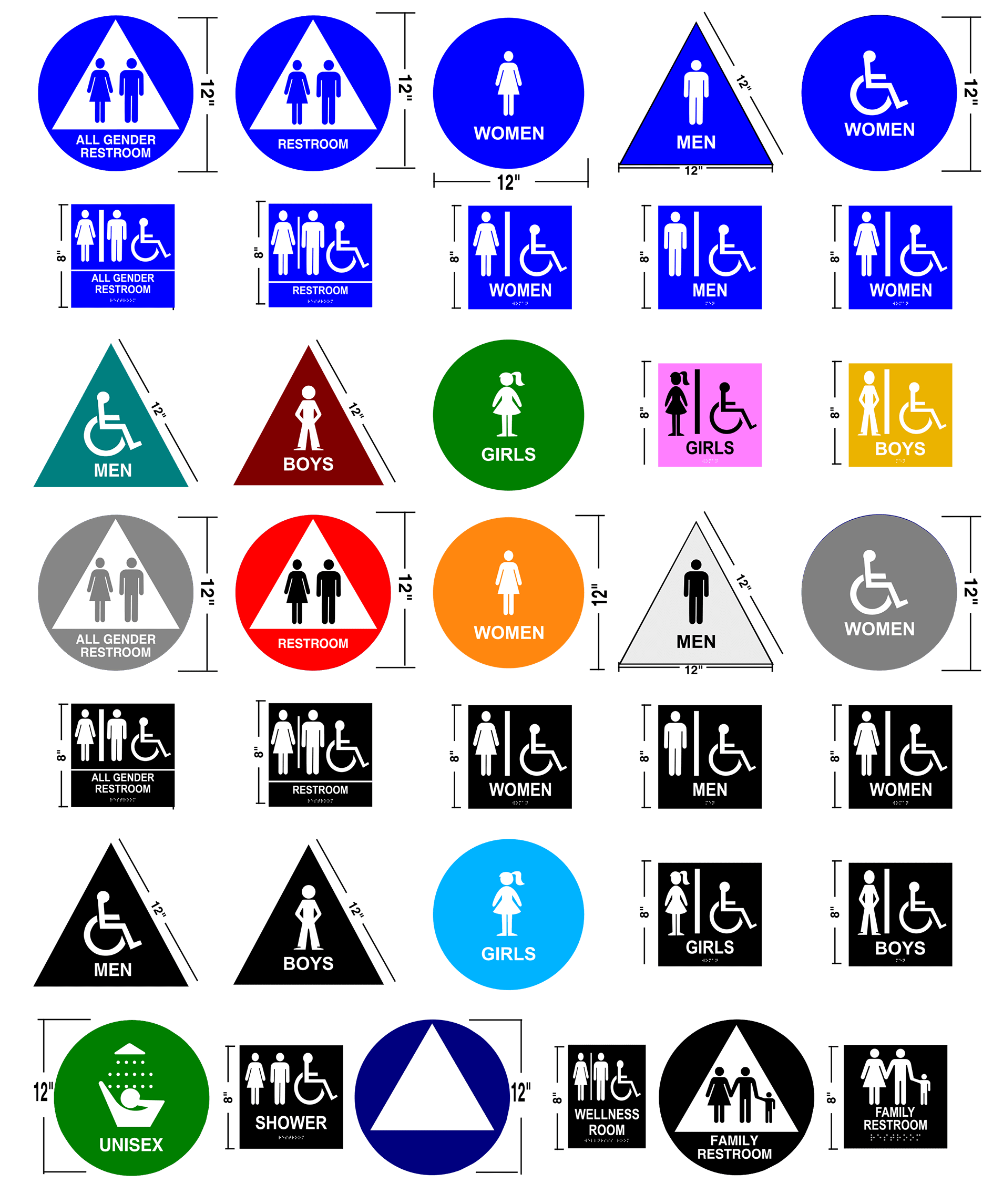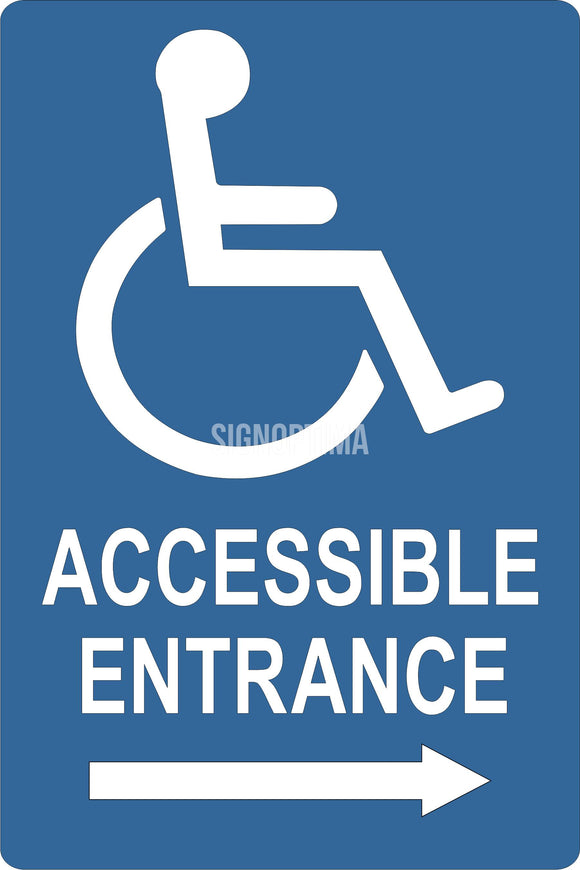ADA Signs: Guaranteeing Ease Of Access and Conformity in Public Spaces
ADA signage plays an important function in assuring accessibility and conformity within public rooms, considerably contributing to a comprehensive environment for people with handicaps. As we discover the subtleties of ADA signs, from responsive features to make intricacies, it's critical to consider exactly how these components integrate to support the civil liberties of all users.
Importance of ADA Signage
In modern culture, the importance of ADA signage prolongs beyond simple conformity with lawful requireds to personify a dedication to inclusivity and accessibility for all individuals. These signs are vital in creating settings where individuals with impairments can browse public rooms with the very same convenience and independence as those without disabilities. By offering clear and standardized details, ADA signs makes sure that every person can access centers, solutions, and information without barriers.
The importance of ADA signage lies in its capacity to boost the quality of life for individuals with impairments by promoting equal access. It gets rid of the challenges that could or else hinder their capacity to participate totally in area life. Furthermore, these indicators offer as noticeable indicators of an organization's dedication to variety and equality, showing broader social worths that promote the civil liberties and dignity of all people.
In addition, ADA signs plays an important role in public security. By guiding people to exits, toilets, and various other vital centers, it makes certain that all individuals, regardless of physical capacity, can evacuate safely during emergencies. In summary, ADA signage is not just a governing demand however an effective tool for promoting a equitable and comprehensive culture.
Secret Elements of Compliance

Placement is essential; indications have to be set up in places that are obtainable and conveniently noticeable. Generally, signs must be placed between 48 and 60 inches from the ground to ensure availability for both standing and mobility device customers. Tactile elements, such as Braille, are vital for people with visual disabilities, offering essential details in a non-visual style.
High-contrast shades in between the text and background are essential to boost readability for people with low vision. The ADA mandates details contrast proportions to make certain quality. Additionally, personality dimension is a key consideration, with minimum elevation needs determined by the watching distance to ensure readability from various angles.
Design Considerations for Availability
Creating obtainable signage requires a meticulous approach to ensure it meets the needs of all users, especially those with impairments. This includes considering various layout components that improve readability and use. Trick aspects include the choice of font, shade comparison, and responsive features. Fonts ought to be sans-serif, with clear and straightforward letterforms, to facilitate easy analysis. The dimension of the message is just as vital, with ADA standards advising a minimum height based upon checking out range to ensure clarity.
Contrasting colors in between text and background are vital for presence, particularly for people with visual problems. A high contrast proportion helps identify the text from its background, boosting readability under various illumination problems. Furthermore, tactile elements, such as Braille and raised personalities, are essential for individuals that are blind or have reduced vision. These elements ought to be situated at a constant elevation and setting to make sure very easy gain access to and comprehension.
Furthermore, the positioning of signage plays a significant function in ease of access. Signs need to be installed in places that are unhampered and quickly obtainable. Making certain that signs is placed at ideal elevations and angles makes it possible for all users, consisting of those utilizing mobility devices, to interact with them efficiently.
Common Mistakes to Stay Clear Of

One more prevalent error is the wrong positioning of signage. ADA guidelines define accurate elevation and area needs to ensure that indications are quickly noticeable and reachable by all people, including those making use of wheelchairs. Neglecting these standards not only interferes with ease of access but likewise takes the chance of non-compliance with lawful criteria.
Additionally, not enough contrast between message and history is a regular oversight. Appropriate contrast is necessary for readability, specifically for individuals with low vision. Developers occasionally pick colors that are visually enticing yet lack the necessary contrast, providing the message difficult to discern.
Finally, some developers stop working to incorporate responsive elements, such as Braille, which are essential for people who are blind. Leaving out these attributes not only causes non-compliance with ADA laws but likewise restricts access for a segment of the population that counts on tactile information.
Future Trends in Signage
Advancements in modern technology and increasing awareness of inclusivity are shaping the future patterns in signage design. As culture discover this becomes extra mindful of diverse demands, the assimilation of smart innovations into signage is gaining grip. Digital signs, for example, is developing to include real-time updates and interactive features, which can be important in giving dynamic information in public rooms. These indicators usually include touch displays or gesture-based controls, allowing users to browse content tailored to their specific requirements.
Another arising pattern is my review here the use of enhanced reality (AR) to improve user experience. AR-enabled signage can overlay electronic info onto the physical setting, offering visually impaired people with auditory or haptic feedback. ADA Signs. This modern technology not only enhances accessibility however also produces an interesting experience for all users
Sustainability is additionally a significant aspect affecting signage patterns. Environment-friendly materials and energy-efficient illumination options are being prioritized to align with worldwide ecological objectives. Innovations in materials science are leading to the advancement of even more weather-resistant and durable indications.
Final Thought
ADA signs plays an essential duty in ensuring availability and compliance within public spaces by incorporating tactile aspects, high-contrast shades, and critical positioning. The adherence to ADA standards not straight from the source only helps with risk-free navigation for individuals with specials needs yet also symbolizes a company's commitment to variety and inclusivity. By preventing typical errors and embracing future patterns, public spaces can remain to progress these worths, guaranteeing that the legal rights and dignity of all individuals are respected and upheld.
ADA signage plays an important function in guaranteeing ease of access and compliance within public spaces, significantly adding to a comprehensive setting for people with handicaps. As we discover the nuances of ADA signage, from responsive functions to develop complexities, it's essential to consider just how these aspects coalesce to copyright the civil liberties of all individuals.In contemporary society, the value of ADA signage extends past simple compliance with legal mandates to embody a dedication to inclusivity and availability for all individuals. By giving clear and standard information, ADA signs makes sure that everyone can access centers, services, and details without barriers.
ADA signs plays an important role in assuring availability and compliance within public areas by incorporating responsive elements, high-contrast colors, and strategic positioning. (ADA Signs)